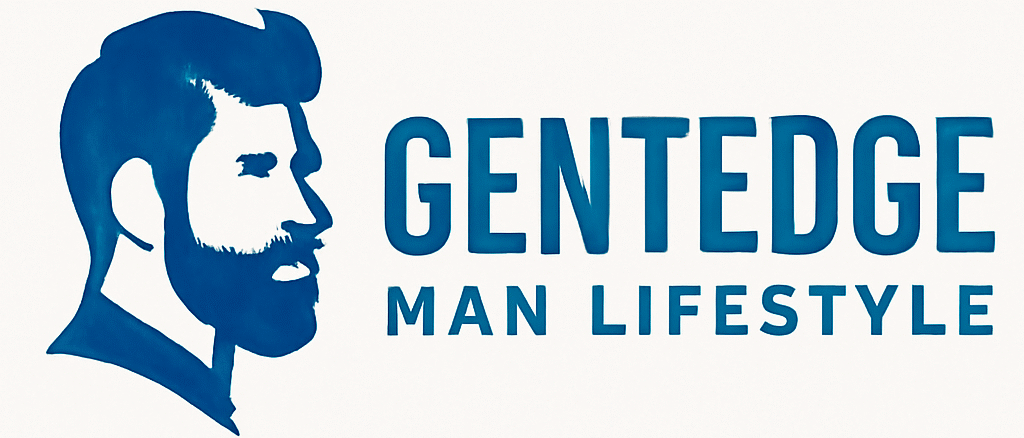Polynesian back tattoos represent some of the most powerful and visually stunning body art choices available to men today. These ancient designs carry deep cultural significance while creating breathtaking artwork that transforms your entire back into a masterpiece of tribal artistry.
We’ve seen countless men choose Polynesian back tattoos because they offer the perfect combination of masculine strength and spiritual meaning. The intricate patterns tell stories of courage bravery and personal journey while showcasing bold geometric designs that command attention and respect.
Whether you’re drawn to traditional Maori ta moko patterns or modern interpretations of Samoan pe’a designs these tattoos create an impressive canvas across your back. The flowing lines and symbolic elements work together to create artwork that’s both deeply personal and universally admired making them an increasingly popular choice among men seeking meaningful body art.
Understanding the Cultural Significance of Polynesian Back Tattoos for Men
Polynesian back tattoos carry profound spiritual meanings that extend far beyond their striking visual appeal. We must recognize these designs as sacred art forms that connect men to ancestral wisdom and cultural identity.
Sacred Traditions and Spiritual Meaning
Traditional Polynesian tattooing represents a spiritual journey that transforms both body and soul. Ancient practitioners believed these intricate designs served as protective armor against evil spirits while channeling ancestral strength into the wearer’s daily life. Each pattern tells a exact story about the man’s lineage, achievements, and spiritual path forward.
Geometric patterns like spearheads symbolize courage and warrior status in battle. Ocean waves represent life’s constant flow and the connection between physical and spiritual realms. Tribal elders traditionally selected these symbols based on individual accomplishments, family history, and personal destiny within the community.
Sacred rituals accompanied every tattooing session in ancient Polynesian culture. Master tattoo artists, known as tufuga ta tatau in Samoa, performed ceremonies to honor the gods and ancestors before beginning their work. These spiritual practices ensured the tattoos carried divine protection and cultural authenticity throughout the recipient’s lifetime.
Respect for Indigenous Heritage
Wearing Polynesian back tattoos requires deep respect for the cultures that created these meaningful designs. We encourage men to research the exact meanings behind each pattern rather than choosing symbols based solely on aesthetic appeal. Understanding the cultural context shows honor to Pacific Islander communities who’ve preserved these traditions for centuries.
Consulting with Polynesian tattoo artists ensures authentic representation of cultural symbols. These experienced practitioners can explain which designs are appropriate for non-Polynesian individuals and which patterns remain sacred to exact island communities. Their guidance helps prevent cultural appropriation while celebrating the beauty of Polynesian artistic heritage.
Learning about Polynesian history and mythology enhances the personal connection to these powerful tattoo designs. Reading traditional stories about Maui, Tangaroa, and other legendary figures provides context for the symbols that appear in back tattoo compositions. This knowledge transforms the tattoo from mere decoration into a meaningful tribute to ancient Pacific Islander wisdom.
Exploring Traditional Polynesian Tattoo Styles for Men’s Backs
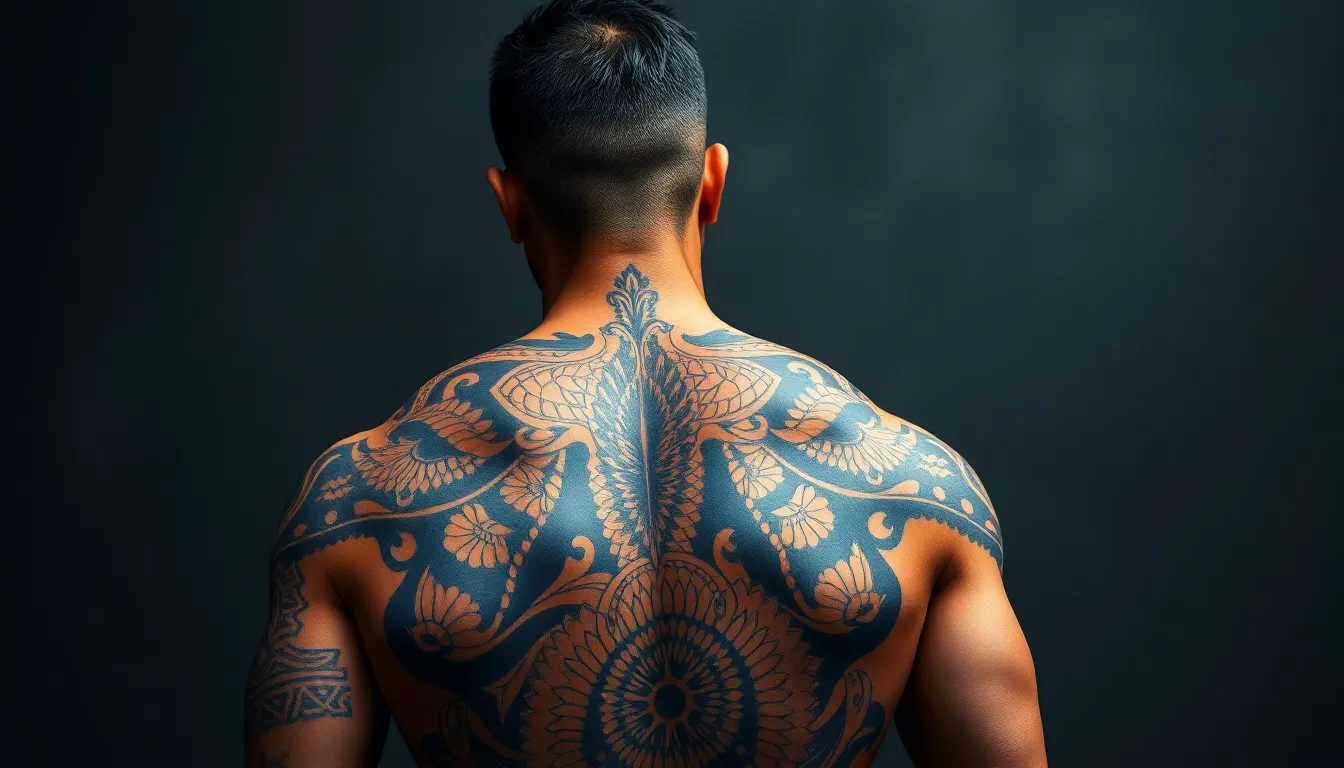
We’ve identified four distinct Polynesian tattoo traditions that create stunning back designs for men, each carrying unique cultural significance and visual elements.
Maori Ta Moko Designs
Maori ta moko tattoos transform men’s backs into powerful canvases of curved lines and intricate spirals that represent ancestral lineage. These designs incorporate the manaia, a spiritual guardian figure combining bird, human, and fish features that provides protection over sky, earth, and sea. Traditional black filled patterns create bold geometric shapes that tell stories of social status and family heritage.
Hei tiki symbols frequently appear in back adaptations, serving as fertility talismans and ancestral connections that link wearers to their Maori roots. Spiral motifs flow across the back’s natural contours, creating movement that represents life’s journey and personal growth. Each curved element connects to form a unified design that honors traditional ta moko principles while adapting to the back’s expansive canvas.
Hawaiian Kakau Patterns
Hawaiian kakau tattoos feature repetitive geometric patterns that cover large portions of men’s backs with bold, symmetrical designs. Triangle motifs, shark teeth symbols, and wave patterns create visual stories of protection, strength, and deep connection to nature. These elements typically arrange in bands and blocks that follow the back’s muscular structure.
Symmetrical layouts ensure balance across the entire back surface, with each pattern element contributing to a larger narrative of personal heritage and achievements. Sharp geometric lines contrast with flowing wave forms, creating ever-changing compositions that capture the essence of Hawaiian island culture. Black ink applications emphasize the bold nature of these traditional designs while maintaining authentic kakau aesthetics.
Samoan Pe’a Influences
Samoan pe’a traditions inspire back tattoos through linear patterns that showcase repeated triangles, waves, and warrior symbols. These designs emphasize courage and dedication to cultural values through sharp edged patterns filled with solid black ink. Linear arrangements create structured compositions that reflect the disciplined nature of traditional Samoan tattooing.
Wave motifs flow horizontally across the back, representing the ocean’s power and the wearer’s connection to island life. Triangle patterns stack vertically to create columns of strength symbols that demonstrate warrior status and personal fortitude. Each geometric element contributes to an overall design that honors the pe’a tradition while adapting to back tattoo applications.
Tahitian Tatau Elements
Tahitian tatau designs integrate animal figures, ocean waves, and geometric shapes into large scale back compositions that represent protection and genealogy. These tattoos commonly feature symmetrical layouts connected by bands and lines that reflect spiritual and social identity. Animal motifs blend seamlessly with geometric patterns to create unified designs.
Fertility symbols and protection elements weave throughout the composition, creating meaningful narratives that span the entire back surface. Ocean wave patterns provide connecting elements between different design sections, maintaining visual flow while incorporating multiple cultural symbols. Black ink applications ensure bold visibility of each tatau element while respecting traditional Tahitian tattooing methods.
Choosing Meaningful Symbols for Your Polynesian Back Tattoo
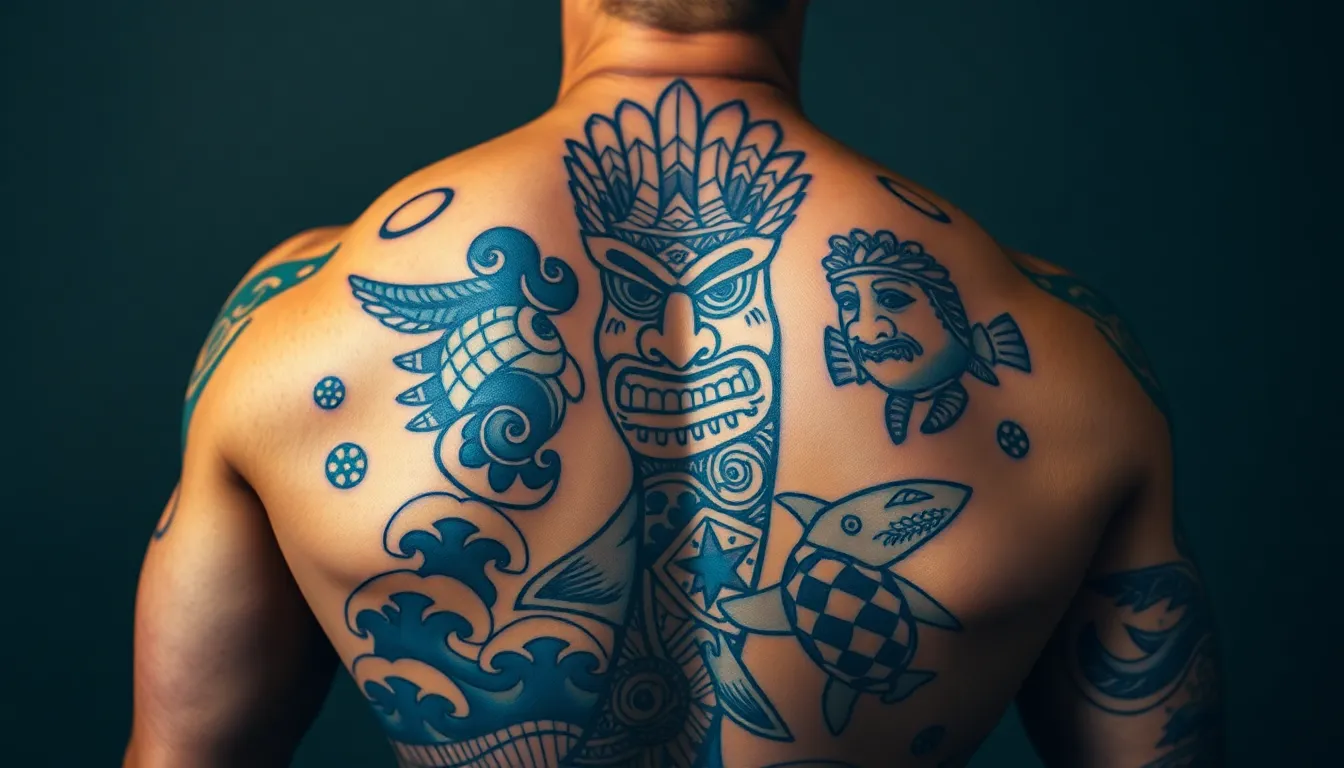
Selecting the right symbols transforms your back tattoo from mere decoration into a powerful narrative of identity and purpose. We’ll explore the most important motifs that create authentic Polynesian artwork.
Tiki Figures and Ancestral Protection
Tiki figures serve as stylized human forms representing ancestral spirits that guard against evil forces. These carved-like designs symbolize gods or revered ancestors who provide spiritual strength to the wearer. Creating rows of tiki figures across your back depicts your lineage and establishes the sacred connection between past and present generations.
Positioning these protective guardians strategically on your back creates a spiritual shield that honors your heritage. Artists often incorporate varying sizes of tiki figures to represent different levels of ancestral importance. Large central tikis typically symbolize primary protective spirits, while smaller surrounding figures represent extended family lineage.
Ocean Waves and Navigation Patterns
Ocean waves hold central importance in Polynesian culture as symbols of life, fertility, persistence, and the afterlife journey. Wave patterns flowing across your back tattoo signify life’s constant motion, embracing change while maintaining continuity through challenges. Expert Polynesian navigators used these oceanic motifs to express guidance through life’s unpredictable waters.
Navigation patterns complement wave designs by representing your personal journey and direction in life. Curved lines mimicking ocean currents create ever-changing movement across your back canvas. Traditional compass-like symbols integrated within wave patterns showcase your ability to find your path even though turbulent times.
Tribal Animals and Spirit Guides
Animals in Polynesian tattoos represent spirit guides that embody exact personal traits and protective qualities. Sharks symbolize protection and strength, making them powerful guardians for warriors and leaders. Turtles represent longevity and peace, connecting the wearer to wisdom and patient endurance through life’s trials.
Each animal carries distinct spiritual significance that reflects your inner virtues and aspirations. Stingrays symbolize grace and adaptability, while dolphins represent friendship and intelligence. Birds like frigate birds showcase freedom and the ability to navigate between earthly and spiritual realms, perfect for men seeking balance in their lives.
Geometric Patterns and Sacred Geometry
Geometric shapes form the foundation of authentic Polynesian design, with spearheads denoting warrior courage and fighting spirit. Triangular patterns create visual strength while representing mountains, shark teeth, or directional movement toward goals. The Marquesan cross stands as a powerful symbol representing balance and universal harmony.
Enata figures appear as stylized human forms within geometric patterns, telling stories of relationships, social rank, and life experiences. These interconnected designs create complex narratives across your back, with each geometric element contributing to your personal story. Sacred geometry principles guide the placement of these patterns, ensuring spiritual significance balances with visual impact.
Planning the Perfect Placement for Men’s Polynesian Back Tattoos
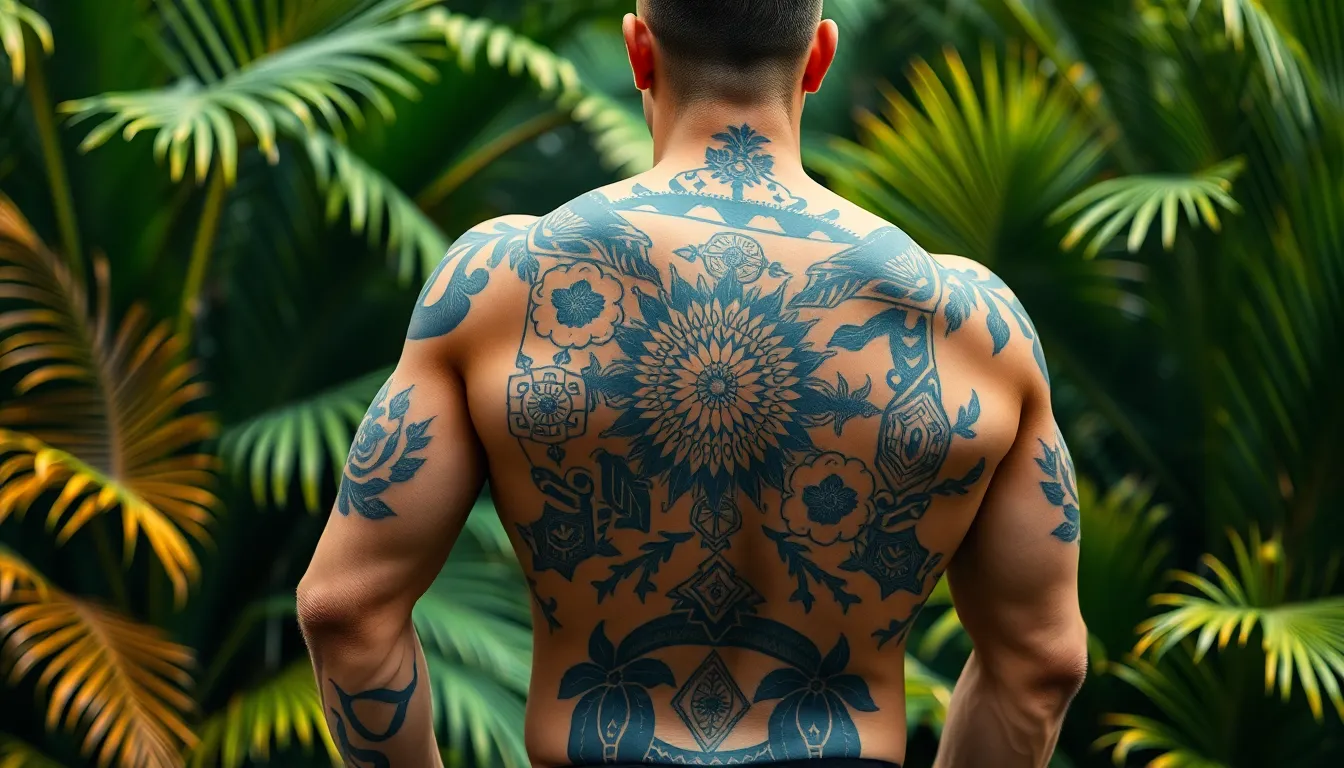
Choosing the right placement transforms your Polynesian tattoo from artwork into a powerful statement of cultural connection and personal identity. Strategic positioning allows each sacred symbol to flow naturally with your body’s contours while maximizing the visual impact of these ancient designs.
Full Back Coverage Designs
Full back coverage creates the ultimate canvas for showcasing complex Polynesian patterns that tell your complete cultural story. Shark teeth, waves, spirals, fish scales, and tribal geometric shapes flow across the entire back surface, representing courage, prosperity, abundance, and protection through interconnected symbolic narratives.
These comprehensive designs work best when incorporating multiple cultural elements like manaia spiritual guardians alongside pakati warrior symbols. Bold geometric patterns create visual harmony while maintaining the sacred meaning behind each traditional motif. Complex compositions allow for detailed storytelling that spans from shoulder to shoulder and neck to lower back.
Artists often structure full coverage pieces around central spine elements that anchor the entire design. Symmetrical patterns radiate outward from this central axis, creating balance while incorporating personal symbols that reflect your individual journey. Large scale designs demand experienced Polynesian tattoo artists who understand proper cultural representation and technical execution.
Upper Back and Shoulder Blade Placement
Upper back and shoulder blade areas provide ideal real estate for featuring prominent Polynesian motifs like the manaia spiritual guardian figure. This placement typically showcases pakati patterns representing warriors and strength, creating bold focal points that command attention and respect.
Shoulder blade positioning allows designs to wrap naturally around the shoulders toward the upper arms or chest area. Integration with half sleeves or full sleeves creates cohesive Polynesian themed artwork that flows seamlessly across multiple body sections. Traditional patterns work exceptionally well in these curved areas, following natural muscle contours.
Artists recommend this placement for first time Polynesian tattoo recipients because it offers substantial space without overwhelming commitment. Shoulder blade designs can stand alone as powerful statements or serve as foundation pieces for future expansions. Visibility control makes this placement popular among professionals who need flexibility in showing or concealing their cultural artwork.
Lower Back and Spine Integration
Lower back and spine placements emphasize verticality and symmetry through patterns like fish scales (unaunahi) representing health and abundance. Taratarekae symbols derived from whale teeth create powerful vertical elements that highlight strength and ancestral connections along the body’s central axis.
Spine aligned tattoos showcase the connection between physical and spiritual realms through balanced geometric arrangements. Central positioning creates striking visual impact while honoring traditional Polynesian beliefs about the body’s sacred energy centers. These designs often incorporate protective symbols that guard the wearer’s spiritual core.
Vertical compositions allow for storytelling that progresses from lower back foundations toward upper spine conclusions. Artists can integrate personal milestones, family lineage markers, and protective symbols in chronological or spiritual sequences. Lower back placement provides excellent canvas space for detailed traditional patterns without overwhelming the overall design composition.
Side Panel Extensions
Side panel tattoos extend Polynesian designs from the back wrapping toward the ribs or torso for ever-changing multi dimensional artwork. Creative flow of traditional patterns like ahuh mataroa (representing achievement and new challenges) creates movement that enhances natural muscular contours and body structure.
These extensions allow for complex storytelling that wraps around the torso, connecting back pieces with chest or abdominal elements. Side placement creates opportunities for incorporating wave patterns, animal spirits, and geometric transitions that wouldn’t fit in traditional rectangular back compositions. Ever-changing positioning makes the tattoo appear to move with your body’s natural motion.
Artists use side extensions to balance asymmetrical back designs or create visual bridges between separate tattoo elements. Rib cage curvature provides natural flow for ocean waves, tribal spirals, and protective symbols that guard the body’s vital organs. Strategic side panel placement transforms static back pieces into living artwork that changes perspective with movement and positioning.
Finding the Right Artist for Polynesian Back Tattoo Work
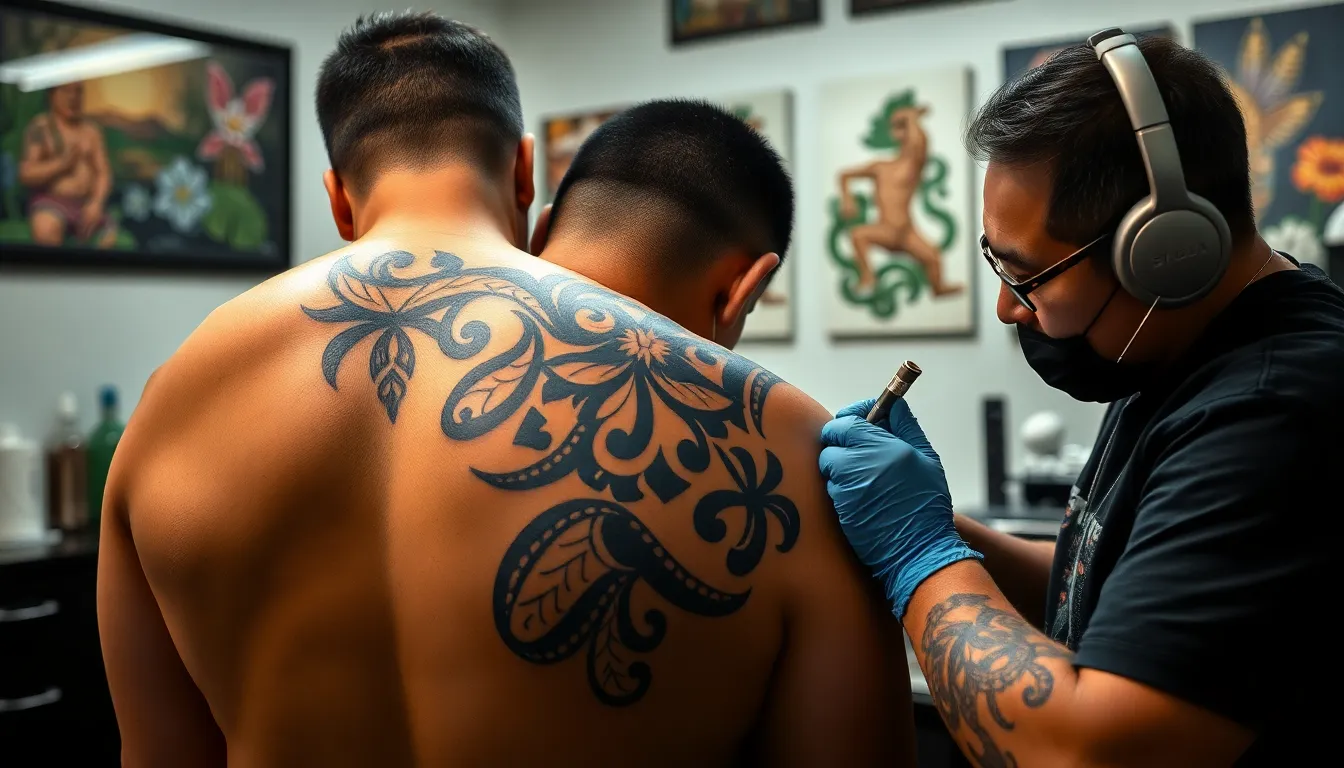
Selecting an artist for your Polynesian back tattoo requires careful consideration since these designs carry deep cultural significance and demand specialized expertise. We’ll guide you through the essential steps to find an artist who can create an authentic, meaningful piece that honors Polynesian traditions.
Researching Cultural Authenticity
Verify the artist’s understanding of Polynesian culture and tattoo symbolism before committing to your design. Authentic Polynesian tattoos require artists who deeply understand the cultural heritage behind each motif, ensuring your tattoo remains respectful and personally meaningful rather than appropriative.
Look for artists who’ve studied traditional Polynesian tattooing methods and can explain the significance of different symbols. Many authentic practitioners have direct connections to Polynesian communities or have undergone formal training in traditional techniques.
Ask potential artists about their approach to incorporating sacred symbols like tiki figures, ocean waves, and tribal animals into back designs. Artists with genuine cultural knowledge will discuss the spiritual meanings behind each element and help you select motifs that align with your personal journey.
Confirm the artist’s commitment to cultural consultation throughout the design process. Respectful practitioners often collaborate with Polynesian cultural advisors or encourage clients to research the meanings behind their chosen patterns to prevent cultural misappropriation.
Portfolio Review and Style Matching
Examine the artist’s portfolio specifically for Polynesian back pieces that demonstrate mastery of traditional patterns and large scale compositions. Look for examples showing how they’ve successfully integrated multiple motifs like spearheads, ocean waves, and geometric patterns into cohesive back designs.
Evaluate their ability to customize designs to body contours since the back provides a broad canvas for intricate, meaningful work. Quality Polynesian artists adapt traditional motifs to flow naturally with your body’s musculature and proportions.
Review how they handle geometric precision in their Polynesian work because authentic designs rely on exact patterns and sacred geometry. Artists should demonstrate consistent line work and symmetry in their traditional Polynesian portfolio pieces.
Study their use of negative space and pattern density in back tattoos to ensure they can create visually balanced compositions. The best Polynesian back tattoos feature strategic spacing that allows each symbol to maintain its cultural significance while contributing to the overall narrative.
Experience with Large-Scale Designs
Prioritize artists who specialize in expansive, complex Polynesian tattoos that require multiple sessions and careful planning. Back pieces often integrate many cultural motifs harmoniously, demanding experience with large scale project management and design continuity.
Confirm their proficiency with freehand design techniques that allow them to perfectly fit tattoos to your body shape and musculature. Experienced Polynesian artists often sketch directly on the skin to ensure the design flows naturally across your back’s curves and contours.
Discuss their approach to session planning for extensive back coverage since these tattoos typically require multiple appointments spanning several months. Artists with large scale experience will provide realistic timelines and healing protocols for complex Polynesian back work.
Verify their ability to maintain design consistency across multiple sessions by reviewing completed back pieces in their portfolio. Skilled practitioners ensure that each section of your Polynesian back tattoo maintains visual harmony and cultural authenticity throughout the extended tattooing process.
Preparing for Your Polynesian Back Tattoo Session
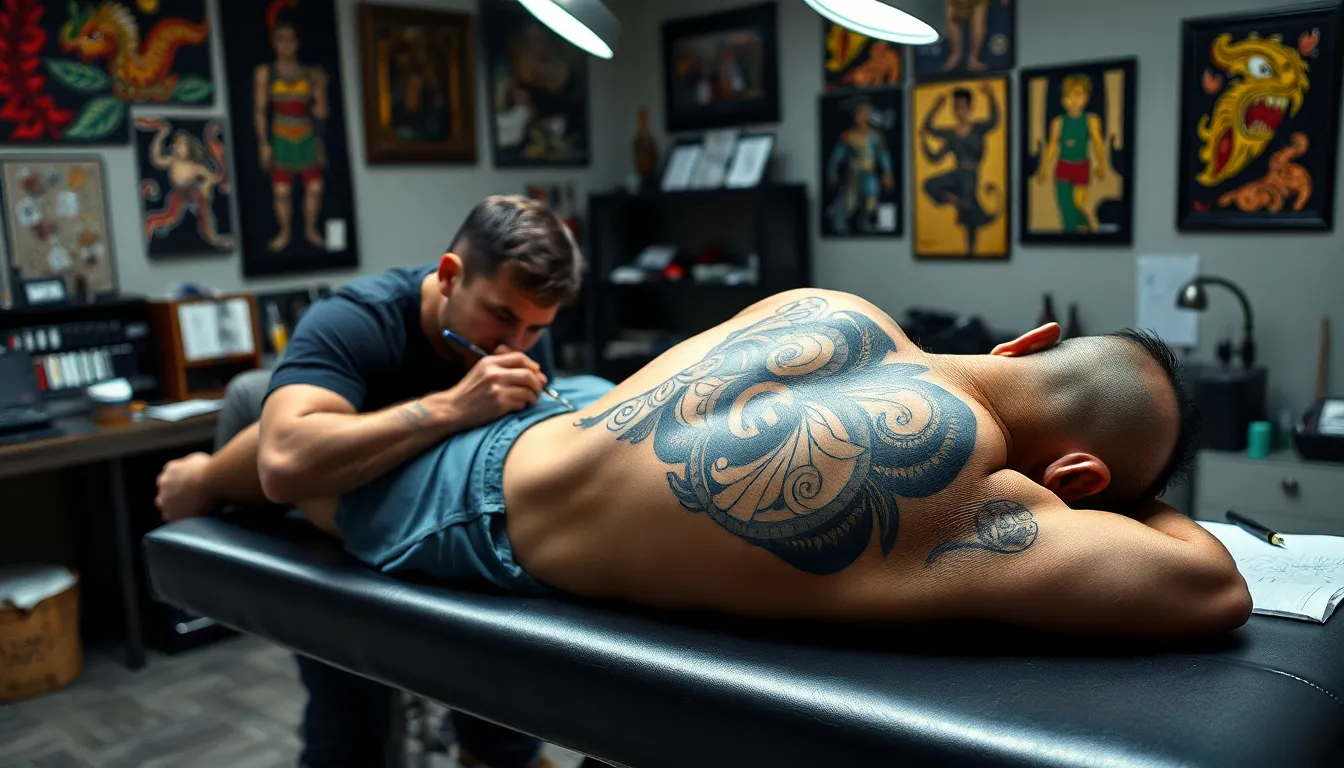
Getting ready for your Polynesian back tattoo requires careful preparation to ensure the best possible experience and results. We’ll guide you through the essential steps to prepare your body and mind for this important commitment.
Physical Conditioning and Pain Management
Building endurance becomes crucial when preparing for extensive Polynesian back tattoo work. Your back provides an ideal canvas for intricate tribal patterns, but the large surface area means you’ll spend long periods sitting or lying in one position. We recommend establishing a regular exercise routine focusing on core strength and flexibility to help maintain comfortable positioning during extended sessions.
Hydrating your body properly in the weeks leading up to your appointment makes a important difference in pain tolerance and healing. Drink plenty of water daily and avoid alcohol for at least 24 hours before each session, as dehydration can intensify discomfort and slow the healing process.
Managing pain expectations helps you prepare mentally for the intensity of back tattoo work. The spine and shoulder blade areas tend to be more sensitive, while the broader back muscles typically handle needle work better. Consider practicing meditation or breathing exercises to develop coping strategies for managing discomfort during your sessions.
Getting adequate rest before each appointment ensures your body can handle the stress of tattooing. We suggest getting 7-8 hours of sleep the night before and eating a substantial meal 2-3 hours before prevent lightheadedness or nausea during the process.
Multiple Session Planning
Scheduling multiple appointments becomes necessary for most Polynesian back tattoos due to their elaborate nature and size. Each session typically focuses on different sections of the design, allowing your skin to heal properly between appointments while your artist crafts detailed, meaningful motifs.
Planning session intervals requires patience, as rushing the process can compromise both the artwork and your health. Most experienced artists recommend waiting 3-4 weeks between sessions to allow complete healing and prevent skin damage or infection.
Designing your layout starts with an initial consultation where you’ll discuss personal symbols, heritage, and stories you want represented. Your artist will sketch rough concepts before freehand drawing the pattern onto your skin, ensuring the design complements your body’s natural contours and muscle definition.
Budgeting for the complete project helps you plan financially for the entire journey. Large Polynesian back pieces often require 4-8 sessions depending on complexity and detail level, with each session potentially lasting 4-6 hours.
Aftercare Preparation
Preparing aftercare supplies before your first session ensures you’re ready to properly care for your new tattoo immediately. Stock up on fragrance free moisturizer, antibacterial soap, and loose fitting clothing that won’t rub against the tattooed area.
Planning recovery time allows optimal healing between sessions and prevents complications. Avoid swimming, saunas, and intense physical activity for 2-3 weeks after each session to protect the healing skin and maintain the tattoo’s quality.
Following detailed instructions from your tattoo artist becomes essential for achieving the best visual and health outcomes. Keep the tattooed area clean and moisturized while protecting it from sun exposure, which can fade the ink and damage healing skin.
Avoiding tight clothing and sleeping positions that might irritate the fresh tattoo helps prevent infection and ensures proper healing. Consider sleeping on your stomach or side to avoid putting pressure on your back during the initial healing period.
Understanding the Investment in Polynesian Back Tattoos for Men
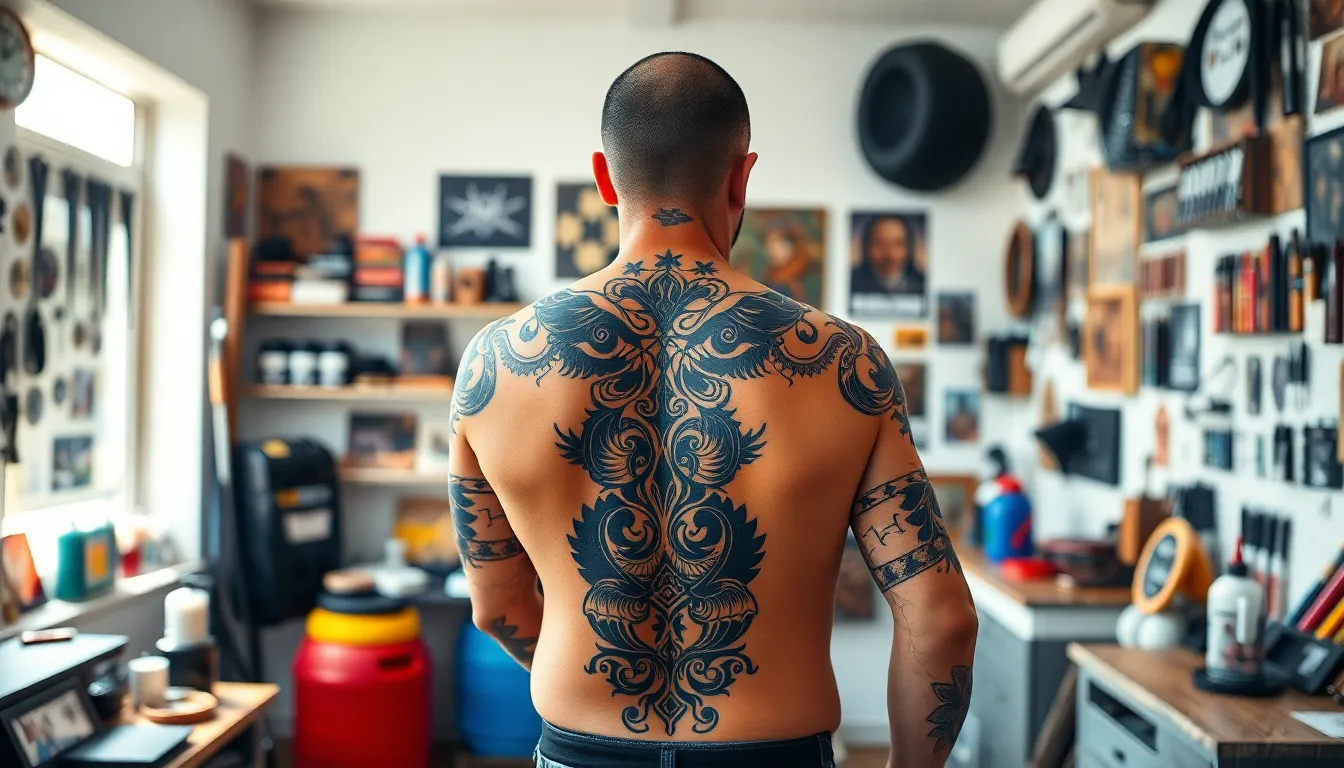
Getting a Polynesian back tattoo represents a important financial and personal investment that extends far beyond the initial studio visit. We need to consider multiple factors that influence both upfront costs and ongoing expenses.
Pricing Factors and Time Commitment
Size and complexity drive the primary cost considerations for Polynesian back tattoos. We typically see prices ranging from $1,500 to $10,000 or more, depending on the design’s intricacy and coverage area. Artist experience and reputation significantly impact these rates, with seasoned professionals commanding higher fees due to their specialized skills in traditional Polynesian techniques.
Studio location affects pricing structures across different markets. Tattoo shops in major cities like Honolulu or other high cost areas charge premium rates compared to smaller towns. Color work versus black and grey designs creates additional cost variations, with colored tattoos requiring more time and specialized expertise.
Time commitment spans multiple dimensions for large back pieces. Session length typically extends several hours per visit, with total project time ranging from 10 to 40 hours depending on design complexity. Multiple appointments become necessary to complete full back coverage, requiring careful scheduling and session planning over several months.
Long-Term Maintenance Costs
Aftercare products represent the immediate post tattoo expenses we encounter. Initial supplies including specialized healing ointments, antibacterial soaps, and protective coverings add modest costs to the overall investment. Touch up sessions may become necessary over time to maintain the tattoo’s visual appeal and color vibrancy.
Proper maintenance extends the artwork’s lifespan and preserves its cultural authenticity. We recommend budgeting for periodic touch ups every few years, particularly for areas exposed to sun and friction. Professional assessment helps determine when refreshing exact design elements becomes beneficial.
Value of Quality Craftsmanship
High quality craftsmanship ensures lasting visual impact and cultural accuracy in Polynesian back tattoos. We find that investing in reputable artists with proven experience creates superior results that maintain their appearance over decades. Custom Polynesian patterns require exceptional skill and attention to traditional design principles.
Expert artisans understand the cultural significance behind each symbol and pattern combination. Their knowledge prevents inappropriate design choices while ensuring authentic representation of Polynesian heritage. Professional execution techniques minimize healing complications and maximize the final artwork’s durability.
Quality investment pays dividends through enhanced aesthetic appeal and reduced maintenance needs. We see well executed pieces retaining their bold lines and intricate details far longer than budget alternatives. Premium craftsmanship also supports the cultural integrity that makes these tattoos meaningful rather than merely decorative.
Maintaining and Caring for Your New Polynesian Back Tattoo
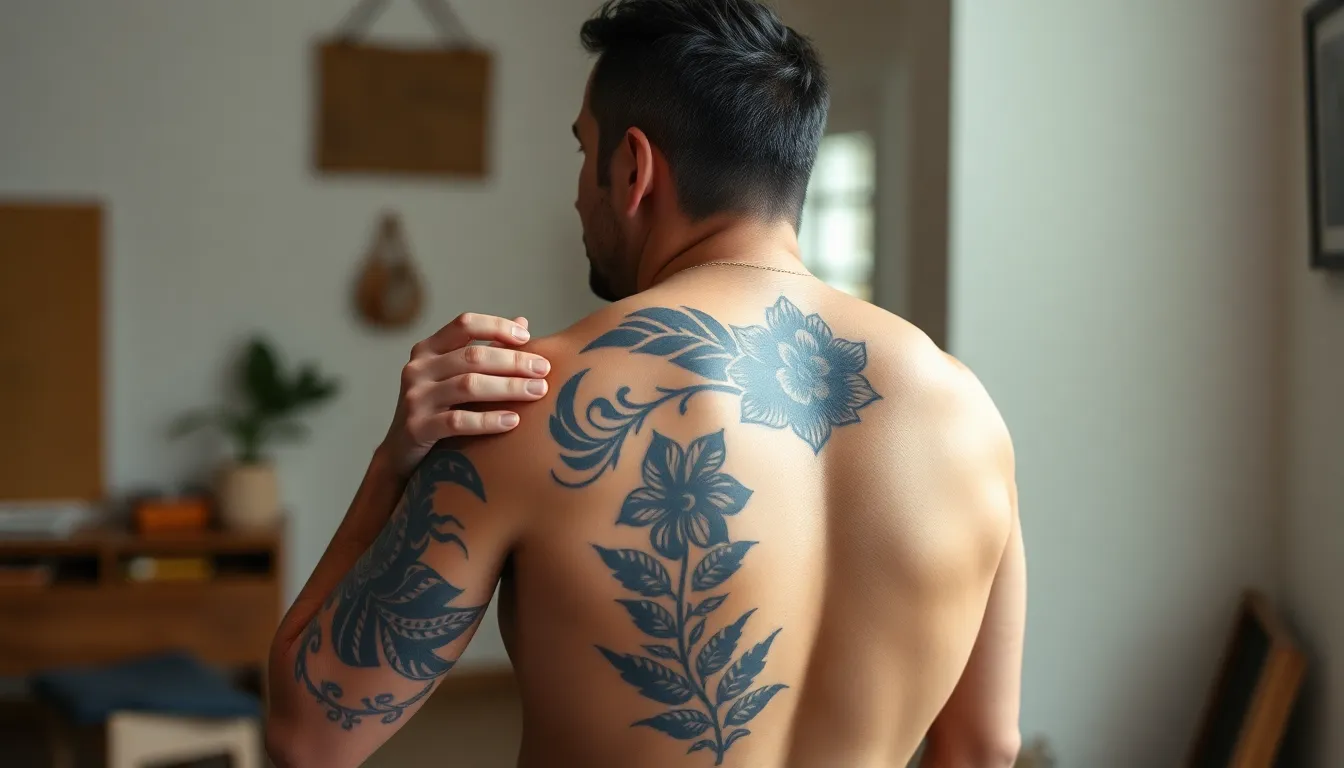
Proper aftercare transforms your investment into a lifetime masterpiece that honors Polynesian culture. We’ll guide you through the essential maintenance steps to ensure your tattoo heals beautifully and retains its cultural significance.
Healing Process Timeline
Fresh Polynesian back tattoos require specialized attention during the first 1-2 weeks due to their size and location. Since reaching your back independently proves challenging, enlist a trusted partner or friend to help clean the area and apply recommended ointments properly.
Sleeping positions demand immediate adjustment to protect your healing artwork. We recommend sleeping on your side or stomach rather than your back to prevent pressure and friction that can damage the fresh tattoo during these critical early days.
Large back designs heal in sections rather than uniformly across the entire piece. Different areas of your Polynesian tattoo may progress through healing stages at varying rates, requiring individualized care approaches for each section to ensure optimal results.
Extended healing periods characterize massive back pieces, with complete recovery often taking several weeks longer than smaller tattoos. Monitor each section carefully and maintain consistent aftercare routines throughout the entire healing timeline.
Sun Protection Strategies
Direct sunlight poses the greatest threat to newly tattooed skin, causing fading or permanent damage to your Polynesian artwork. Keep your tattoo completely covered or stay indoors during peak UV hours for the first month after getting inked.
Strong sunscreen becomes essential once your tattoo fully heals and you can safely apply topical products. We recommend using SPF 30 or higher specifically designed for tattoo protection to preserve the intricate details of your Polynesian designs.
Long term protection requires consistent sunscreen application even years after your tattoo heals completely. UV rays continue threatening your tattoo’s vibrancy and can cause premature aging of the ink, diminishing the bold cultural statement your back piece represents.
Clothing coverage offers additional protection when spending extended time outdoors during healing and beyond. Loose fitting shirts prevent irritation while providing an extra barrier against harmful sun exposure.
Touch-Up Scheduling
Post healing assessment reveals areas that may need enhancement to maintain the tattoo’s cultural authenticity and visual impact. Schedule an evaluation with your original artist 6-8 weeks after complete healing to identify any fading or patchiness.
Periodic touch ups become necessary for large Polynesian back designs to maintain their clarity and traditional detail over the years. Most quality back pieces require minor touch up work every 5-10 years depending on sun exposure and skin care habits.
Regular hydration supports your tattoo’s long term health and reduces the frequency of needed touch ups. Well moisturized skin maintains tattoo vibrancy longer and prevents cracking that can damage the intricate geometric patterns characteristic of Polynesian artwork.
Professional maintenance consultations help preserve your tattoo’s cultural significance and visual appeal throughout your lifetime. Working with artists familiar with Polynesian traditions ensures any touch up work respects the original design’s sacred meaning and artistic integrity.
Conclusion
Polynesian back tattoos represent one of the most profound ways we can honor ancient Pacific Islander traditions while creating deeply personal artwork. These sacred designs transform our backs into powerful canvases that tell stories of courage heritage and spiritual connection.
The journey to getting an authentic Polynesian back tattoo requires careful consideration from choosing culturally respectful symbols to finding skilled artists who understand traditional meanings. We must approach this art form with reverence and genuine appreciation for its cultural significance.
When we invest in quality craftsmanship and proper aftercare we’re not just getting a tattoo – we’re carrying forward centuries of Polynesian wisdom and artistry. These magnificent designs serve as permanent reminders of our commitment to honoring indigenous cultures while expressing our own personal narratives through timeless geometric patterns and sacred symbols.
Frequently Asked Questions
What makes Polynesian back tattoos so popular among men?
Polynesian back tattoos combine powerful visual impact with deep cultural meanings, representing masculine strength and spiritual narratives. The large back canvas allows for intricate geometric patterns that showcase courage, personal journeys, and ancestral connections. These designs transform the back into bold artwork that is both personally meaningful and widely respected.
What are the main types of Polynesian tattoo traditions for back designs?
The four main traditions are Maori ta moko (curved lines and spirals representing lineage), Hawaiian kakau (bold geometric patterns for protection), Samoan pe’a (linear patterns emphasizing warrior status), and Tahitian tatau (animal figures and ocean waves reflecting genealogy). Each tradition offers unique cultural significance and visual elements.
How important is cultural respect when getting a Polynesian tattoo?
Cultural respect is crucial to prevent appropriation and honor indigenous heritage. Research the meanings behind each pattern, consult with authentic Polynesian tattoo artists, and ensure proper representation. This approach fosters deeper understanding of Polynesian history and transforms tattoos into meaningful tributes to ancient Pacific Islander wisdom.
What do common Polynesian tattoo symbols mean?
Tiki figures represent ancestral protectors, ocean waves symbolize life’s journey, and tribal animals serve as spirit guides with distinct traits. Geometric patterns tell complex stories through sacred geometry. Spearheads represent courage, while various motifs combine to create powerful narratives of identity and purpose across the back.
How should I choose placement for my Polynesian back tattoo?
Consider full back coverage for comprehensive storytelling, upper back for prominent motifs, lower back and spine for vertical symmetry, or side panels for dynamic flow. Each placement enhances visual impact differently. Strategic positioning strengthens cultural connection and allows the design to complement your body’s natural contours.
How do I find the right artist for Polynesian tattoo work?
Research artists’ cultural authenticity and understanding of Polynesian symbolism. Review portfolios for mastery of traditional patterns and large-scale design experience. Ensure they can customize designs and demonstrate freehand technique proficiency. The artist should maintain design consistency across multiple sessions and prevent cultural misappropriation.
How much does a Polynesian back tattoo cost?
Costs range from $1,500 to $10,000 or more, depending on size, complexity, and artist reputation. Large pieces require 10-40 hours across multiple sessions. Additional costs include aftercare products and potential touch-ups. Investing in skilled artists ensures superior results that maintain cultural integrity and appearance over time.
What’s involved in preparing for a Polynesian back tattoo?
Physical preparation includes proper hydration, rest, and pain management planning. Schedule multiple sessions with healing intervals between appointments. Budget for the entire project and prepare aftercare supplies in advance. Mental readiness is important given the time commitment and cultural significance of the artwork.
How do I care for a Polynesian back tattoo during healing?
Follow proper aftercare instructions including gentle cleaning and moisturizing. You’ll need assistance caring for the tattoo due to its size and back location. Adjust sleeping positions to protect the artwork, avoid sun exposure, and attend follow-up appointments. The healing process typically takes several weeks with specific timeline phases.
How do I maintain my Polynesian back tattoo long-term?
Protect from sun exposure using high-SPF sunscreen to prevent fading. Schedule periodic touch-ups to maintain clarity and cultural authenticity. Use quality moisturizers to keep skin healthy. Regular maintenance preserves the tattoo’s appearance and ensures the cultural significance remains intact throughout your lifetime.
